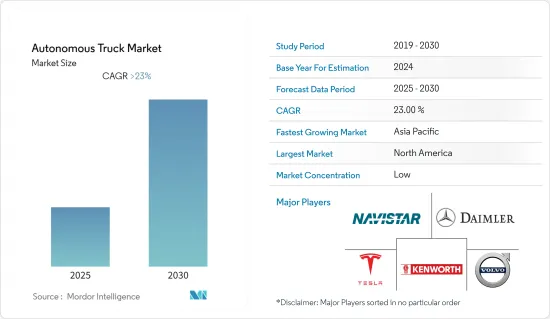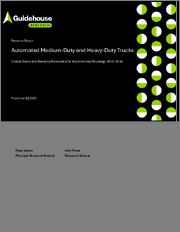
|
시장보고서
상품코드
1683199
자율주행 트럭 : 시장 점유율 분석, 산업 동향 및 통계, 성장 예측(2025-2030년)Autonomous Truck - Market Share Analysis, Industry Trends & Statistics, Growth Forecasts (2025 - 2030) |
||||||
자율주행 트럭 시장은 예측 기간 동안 23% 이상의 CAGR을 나타낼 것으로 예상됩니다.

코로나19 팬데믹은 전체 자동차 산업 부문에 비해 상대적으로 미미한 영향을 미쳤습니다. 팬데믹으로 인한 봉쇄와 전 세계 운송 중단으로 인해 자율주행 트럭에 대한 수요는 약간 방해를 받았습니다. 그러나 시장과 무역이 점차 개방되고 자동화의 필요성이 증가함에 따라 자율 주행 트럭 시장은 경제적 회복을 기대하고 있습니다.
주요 하이라이트
- 시장 성장을 이끄는 주요 요인으로는 신흥 시장의 산업 부문 확대, 물류 산업 수요 증가, 건설 부문 수요 증가(건설 활동 증가로 인한) 등이 있습니다. 신흥국 및 선진국의 경제 성장으로 인해 향후 몇 년동안 시장이 성장할 것으로 예상됩니다.
- 자율주행/무인 트럭은 편의성 측면에서 기존 트럭을 대체할 수 있는 큰 잠재력을 가지고 있지만, 제조 비용, 적절한 인프라 부족, 정부의 미흡한 규제와 정책, 통근자 및 보행자 안전 등이 성장의 걸림돌로 작용하고 있습니다. 자율주행차 사고는 36건이 보고된 바 있습니다.
- 자동차 안전에 대한 수요 증가와 정부의 엄격한 규제가 ADAS 시장의 성장을 견인하고 있습니다. 미국 고속도로교통안전국(NHTSA)은 2022년 9월 1일까지 8501파운드에서 10000파운드의 모든 트럭에 자동 비상 브레이크 장착을 의무화했습니다. 또한, 영국은 커넥티드 및 자율주행차 센터(CAV)를 설립하고 고속도로와 도로에서 차량 테스트를 허용하는 법과 규정을 마련하기 위해 노력하고 있습니다.
자율주행 트럭 시장 동향
ADAS 수요 증가 추세
고객의 인식이 높아지면서 자율주행 기능과 첨단 안전 기능을 갖춘 차량에 대한 수요 증가로 이어지고 있습니다. 차량에 ADAS 시스템을 선택한 고객의 90%는 반복 구매자가 됩니다. 정부의 규범과 정책도 ADAS 시장 판매를 촉진하고 있습니다. 미국과 유럽 당국은 2022년까지 자동차 긴급제동장치(AEB) 장착을 의무화하고 2020년까지 전방충돌방지/경보 시스템 장착을 의무화할 예정입니다.
완전한 ADAS 시스템은 고가의 고급 차량에만 장착되어 있습니다. 많은 트럭 OEM들은 ADAS 제조업체와 협력하여 저가의 ADAS 시스템을 생산하고 있습니다. 그러나 자동차(상용차 및 승용차)의 가격은 연평균 1%의 미미한 성장을 기록하는 반면, ADAS 시스템은 높은 제조 비용으로 인해 고가이며, OEM은 소형 및 중형차 부문의 가격 상승을 꺼려하고, ADAS 기업은 기대만큼의 수익을 얻지 못할 수 있습니다. 이 요인은 ADAS 시장의 성장을 저해할 수 있습니다.
주요 OEM 공급업체들은 ADAS를 개발하기 위해 기술 회사와 협력하는 전략을 채택하고 있으며, Nvidia와 같은 기술 회사는 이 분야에 진출하여 Volvo와 Paccar와 같은 회사에 서비스를 제공합니다. 아마존은 엠바크(Embark)의 자율주행 트럭을 이용해 화물을 배송하고 있습니다.
패시브 세이프티(충돌 시 또는 충돌 후 운전자의 부상을 방지하는 안전 대책)는 지난 수십년동안 많은 기술 혁신이 있었지만, 신흥국 시장에서는 개선의 여지가 거의 없습니다. 개발업체들은 현재 신흥국 시장에서 최고의 패시브 세이프티를 제공하는 데 주력하고 있습니다. 액티브 세이프티(충돌 예측 및 회피)는 아직 초기 단계에 있으며, 제공할 수 있는 것이 많습니다. 대다수 업체들이 조기에 승인한 ADAS 기술은 향후 완전자율주행차 개발에 중요한 역할을 할 것으로 보입니다.
자율주행 트럭 시장을 선도하는 북미
자율주행 트럭은 유럽, 아시아태평양 등 전 세계적으로 도입 초기 단계에 있지만, 북미는 인프라가 잘 갖추어져 있고 자율주행 분야에 진출한 주요 기술 기업들이 있어 현재 가장 큰 시장으로 꼽힙니다.
테슬라를 비롯한 기업들의 인프라 개척을 통한 자동차 신흥국 시장의 전동화도 북미 시장을 견인하고 있습니다. 전기자동차에 x-by-wire 기술 도입은 자율주행의 향상에 도움이 되고 있습니다.
2021년 9월, PACCAR는 자율주행 기술 선도기업인 오로라(Aurora)와 제휴하여 워싱턴에서 자율주행 트럭의 운송 업무에 대한 상업적 시험 운행을 시작했습니다. 이 기술은 페덱스에 채택될 것으로 예상됩니다.
2019년 다임러 트럭 북미는 토크 로보틱스(Torc Robotics)와 협력하여 버지니아 주 81번 주간 고속도로에서 자율 주행 트럭을 테스트하기 시작했으며, CES 2020에서 켄워스 트럭은 T680 트럭을 기반으로 한 자율 주행 트럭 기술을 발표했습니다. 이 자율 주행 트럭은 센서와 LiDAR를 사용하여 주행 중 시간당 최대 1 테라바이트의 데이터를 수집합니다.
자율주행 트럭 산업 개요
자율 주행 트럭 시장은 다음과 같은 기업들에 의해 확고하게 굳어지고 있습니다. Daimler, Volvo, Tesla, etc. 주요 전략은 기술 기업들과 협력하여 인공지능(AI), 로봇 공학, 고급 분석, 사물인터넷, 클라우드 기술 등의 서비스를 자율 주행 트럭의 제조 및 운영에 통합하는 것입니다.
기타 혜택
- 엑셀 형식 시장 예측(ME) 시트
- 3개월간 애널리스트 지원
목차
제1장 서론
- 조사의 전제조건
- 조사 범위
제2장 조사 방법
제3장 주요 요약
제4장 시장 역학
- 시장 성장 촉진요인
- 시장 성장 억제요인
- 업계의 매력 - Porter의 Five Forces 분석
- 신규 진출업체의 위협
- 구매자/소비자의 교섭력
- 공급 기업의 교섭력
- 대체품의 위협
- 경쟁 기업간 경쟁 관계
제5장 시장 세분화
- 유형별
- 소형 트럭
- 중형 트럭
- 대형 트럭
- 자동화 레벨별
- 반자율주행
- 완전 자율주행
- ADAS 기능별
- 어댑티브 크루즈 컨트롤
- 차선이탈 경보
- 지능형 주차 보조
- 하이웨이 파일럿
- 자동 긴급제동장치
- 사각지대 감지
- 트래픽 잼 어시스트
- 레인 보관 어시스트 시스템
- 컴포넌트 유형별
- 라이더
- 레이더
- 카메라
- 센서
- 구동 유형별
- IC 엔진
- 전기식
- 하이브리드
- 지역별
- 북미
- 미국
- 캐나다
- 기타 북미
- 유럽
- 독일
- 영국
- 프랑스
- 러시아
- 스페인
- 기타 유럽
- 아시아태평양
- 중국
- 일본
- 인도
- 한국
- 기타 아시아태평양
- 세계 기타 지역
- 남미
- 중동 및 아프리카
- 북미
제6장 경쟁 구도
- 벤더의 시장 점유율
- 기업 개요
- AB Volvo
- Mercedes Benz Group
- Traton SE
- TuSimple
- Fabu Technology
- Tesla Inc.
- Paccar Inc
- BYD Co. Ltd.
- Einride
- Embark
제7장 시장 기회와 향후 동향
LSH 25.03.27The Autonomous Truck Market is expected to register a CAGR of greater than 23% during the forecast period.

The COVID-19 pandemic had a relatively more minor impact on this automotive industry segment compared to the whole. The demand for autonomous trucks was slightly hindered due to the lockdown and global transportation halt due to the pandemic. However, with market and trade gradually opening up and the increased need for automation, the autonomous truck market is hoping for an economic revival.
Key Highlights
- Some major factors driving the growth of the market are the expansion of industrial sectors in the emerging market, growing demand from the logistics industry, and rising demand from the construction sector (owing to growing construction activities). The market is expected to witness growth in the coming years due to growing economies across developing and developed counties.
- Although autonomous/driverless trucks have a great potential to replace conventional trucks in terms of convenience-high, cost of manufacturing, lack of proper infrastructures, inadequate regulations and policies of governments, and safety of commuters and pedestrians are some of the reasons are acting as a hindrance in the growth. There have been 36 reported accidents involving autonomous vehicles.
- The rising demand for vehicle safety and stringent government rules drive the ADAS market growth. National Highway Traffic Safety Administration (NHTSA) makes it mandatory for all trucks with weights ht range from 8501 lb. to 10000 lb. to be equipped with Automatic Emergency Braking by September 1, 2022. United Kingdom has also set up a Centre for Connected and Autonomous Vehicles (CAV) that is working towards establishing laws and regulations to allow vehicle testing on highways and roads.
Autonomous Truck Market Trends
ADAS demand is on the rise
Rising awareness among customers is leading to growth in demand for vehicles with autonomous and advanced safety features. 90% of the customers who opt for any ADAS system in their vehicle become repeat purchasers. Government norms and policies are also boosting the sales of the ADAS market. US and European authorities will make the installation of Automotive Emergency Braking (AEB) mandatory by 2022 and the Forward Collision Avoidance/Warning System by 2020.
The complete ADAS systems are featured in expensive luxury segment vehicles only. Many truck OEMs collaborate with ADAS manufacturing companies to produce low-cost ADAS systems. However, vehicles (commercial and passenger) register a minute average annual growth of 1% in their prices, while ADAS systems are expensive due to their high manufacturing cost. OEMs may show reluctance in increasing the prices of small and mid-sized vehicle segments, and ADAS companies might not get the expected return. This factor might hinder the growth of the ADAS market.
Top OEM suppliers have adopted the strategy of partnering with technology companies to develop ADAS. Tech companies like Nvidia have entered this space to provide services to companies such as Volvo and Paccar. Amazon is using Embark's self-driving trucks to deliver its cargo.
Passive safety (safety measures to prevent drivers from injuries during or after the crash) has seen a lot of innovations in the past decades, andminimale scope for improvement is left to make in the markets of developed geographies. Companies are now focusing on providing the best passive safety in developing markets. Active Safety (to predict and avoid crashes) is in its initial stage and has a lot to offer. Any ADAS technology that gets early approval from a majority of players will play a crucial role in the development of fully autonomous vehicles in the future.
North America is leading the autonomous truck market
Although Autonomous trucks are in the early stage of adoption across the globe in geographies such as Europe and the Asia Pacific, North America is currently the largest market due to the availability of infrastructure and significant technology companies that are entering autonomous driving segment.
The rising electrification of vehicles due to infrastructure development by companies such as Tesla is also propelling the market in North America. The induction of x-by-wire technology in electric vehicles is helping in the improvement of autonomous driving.
In Sep 2021, PACCAR teamed up with Aurora, a leading autonomous driving technology company, to launch a commercial pilot of autonomous trucks in hauling operations in Washington. The technology is expected to be used by FedEx.
In 2019, Daimler Trucks North America partnered with Torc Robotics and started testing autonomous trucks at Interstate 81 in Virginia. At CES 2020, Kenworth Truck Co. unveiled its autonomous truck technology based on the T680 truck. The autonomous truck uses sensors and LiDAR and collects up to 1 terabyte of data per hour during driving.
Autonomous Truck Industry Overview
The autonomous truck market is firmly consolidated by players such as Daimler, Volvo, Tesla, etc. The primary strategy players adopt collaborating with technology companies to integrate services such as artificial intelligence (AI), robotics, advanced analytics, Internet of Things, Cloud technology, etc., in the production and operation of autonomous trucks.
- In Sep 2021, Volvo Autonomous Solutions revealed a prototype long-haul autonomous truck for the North America application.
Additional Benefits:
- The market estimate (ME) sheet in Excel format
- 3 months of analyst support
TABLE OF CONTENTS
1 INTRODUCTION
- 1.1 Study Assumptions
- 1.2 Scope of the Study
2 RESEARCH METHODOLOGY
3 EXECUTIVE SUMMARY
4 MARKET DYNAMICS
- 4.1 Market Drivers
- 4.2 Market Restraints
- 4.3 Industry Attractiveness - Porter's Five Forces Analysis
- 4.3.1 Threat of New Entrants
- 4.3.2 Bargaining Power of Buyers/Consumers
- 4.3.3 Bargaining Power of Suppliers
- 4.3.4 Threat of Substitute Products
- 4.3.5 Intensity of Competitive Rivalry
5 MARKET SEGMENTATION
- 5.1 Type
- 5.1.1 Light-duty Trucks
- 5.1.2 Medium-duty Trucks
- 5.1.3 Heavy-duty Trucks
- 5.2 Level of Autonomy
- 5.2.1 Semi-Autonomonus
- 5.2.2 Fully Autonomoys
- 5.3 ADAS Features
- 5.3.1 Adaptive Cruise Control
- 5.3.2 Lane Departure Warning
- 5.3.3 Intelligent Park Assist
- 5.3.4 Highway Pilot
- 5.3.5 Automatic Emergency Braking
- 5.3.6 Blind Spot Detection
- 5.3.7 Traffic Jam Assist
- 5.3.8 Lane Keeping Assist System
- 5.4 Component Types
- 5.4.1 LIDAR
- 5.4.2 RADAR
- 5.4.3 Camera
- 5.4.4 Sensors
- 5.5 Drive Type
- 5.5.1 IC Engine
- 5.5.2 Electric
- 5.5.3 Hybrid
- 5.6 Geography
- 5.6.1 North America
- 5.6.1.1 United States
- 5.6.1.2 Canada
- 5.6.1.3 Rest of North America
- 5.6.2 Europe
- 5.6.2.1 Germany
- 5.6.2.2 United Kingdom
- 5.6.2.3 France
- 5.6.2.4 Russia
- 5.6.2.5 Spain
- 5.6.2.6 Rest of Europe
- 5.6.3 Asia-Pacific
- 5.6.3.1 China
- 5.6.3.2 Japan
- 5.6.3.3 India
- 5.6.3.4 South Korea
- 5.6.3.5 Rest of Asia-Pacific
- 5.6.4 Rest of the World
- 5.6.4.1 South America
- 5.6.4.2 Middle-East and Africa
- 5.6.1 North America
6 COMPETITIVE LANDSCAPE
- 6.1 Vendor Market Share
- 6.2 Company Profiles
- 6.2.1 AB Volvo
- 6.2.2 Mercedes Benz Group
- 6.2.3 Traton SE
- 6.2.4 TuSimple
- 6.2.5 Fabu Technology
- 6.2.6 Tesla Inc.
- 6.2.7 Paccar Inc
- 6.2.8 BYD Co. Ltd.
- 6.2.9 Einride
- 6.2.10 Embark



















